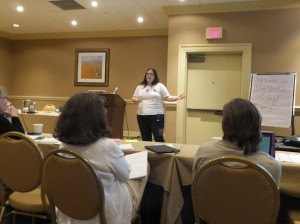 As Agile2013 considers itself a best in class kind of conference “designed to provide all Agile Team Members, Developers, Managers and Executives with proven, practical knowledge”, the track committees select from a large pool of applicants and prefer vetted content that has worked its way up from local meetings to conferences. I have only one talk that fits this criteria since I presented Big Visible Testing as an emerging topic at CAST 2012. I developed several versions of this talk subsequent to that event and doing so had given me confidence that I would be able to provide valuable information in the time allotted and still leave enough time for attendees to ask questions and to give feedback on what information resonated with them.
As Agile2013 considers itself a best in class kind of conference “designed to provide all Agile Team Members, Developers, Managers and Executives with proven, practical knowledge”, the track committees select from a large pool of applicants and prefer vetted content that has worked its way up from local meetings to conferences. I have only one talk that fits this criteria since I presented Big Visible Testing as an emerging topic at CAST 2012. I developed several versions of this talk subsequent to that event and doing so had given me confidence that I would be able to provide valuable information in the time allotted and still leave enough time for attendees to ask questions and to give feedback on what information resonated with them.
I worked to carefully craft this proposal for the experience reports track, knowing that if I were selected that I would have a formal IEEE-style paper to write. Fortunately, my talk made the cut and I began the writing process with my intrepid “shepherd” Nanette Brown. I wasn’t sure where to begin with writing a formal paper, but Nanette encouraged me to simply begin to tell the story and worry about the formatting later. This proved to be wise advice since telling a compelling story is the most important task. Harkening back to my high school and early college papers, I found myself wading through different but largely similar drafts of my story. I experimented with choosing a different starting point for the paper that I ultimately discarded, but it had served its purpose in breaking through my writer’s block. Focusing on how the story would be valuable to my readers helped to hone in on sequencing and language selection. Once I had the prose sorted out, I began to shape the layout according to the publication standards and decided to include photographs from my presentation – the story is about big visible charts after all!
Investing sufficient time in the formal paper made preparing the presentation more about strong simple visuals. I have discovered my own interest in information visualization so prototyping different slide possibilities and testing them out with colleagues was (mostly) fun. I’m still not quitting my day job to go into slide deck production. Sorry to disappoint!
Performance anxiety
Despite all of this preparation, I couldn’t sit still at dinner the night before my presentation and barely slept that night. I woke before the sunrise and tried to school my mind to be calm, cool, and collected while the butterflies in my stomach were trying to escape. This was definitely the most challenging work of presenting!
As a first time speaker, I didn’t know what to expect, so I set my talk’s acceptance criteria as a rather low bar:
- Someone shows up
- No one hates it enough to leave a red card as feedback
When I walked into my room in the conference center, a lone Agile2013 attendee was waiting for me. Having him ready to go encouraged me to say hello to each of the people who came to my presentation, which in turn changed the people in the room from a terrifying Audience into many friends, both new and old. I think I managed not to speed through my slides despite my tendency to chatter when I’m nervous. I couldn’t stay trapped behind my podium and walked around to interact with my slides and to involve my audience more in the conversation. Sadly, I can’t share my energy with you since I forgot to record it. Oh well. Next time!
The vanity metrics
- At 10 minutes into the presentation, 50 people had come to hear me speak and at 60 minutes I had somehow gained another 7 to end at 57 people. Thanks so much for your kind attention! I hope I made it worth your while…
- 43 people stopped to give me the simple good-indifferent-bad feedback of the color-coded cards (which I liked as a simple vote about a presentation) and I received 37 green cards and 6 yellow – with no red cards! Whoo hoo!
Words of Encouragement
Two people kindly wrote out specific feedback for me and I want to share that with you in detail, hoping to elicit some late feedback from attendees who might like to share at this point (Agree or disagree, I want to hear from you!)
Feedback Card #1:
– Best session so far!
– Great presenter – great information – great facilitator
– Would like to see future sessions by this speaker
Feedback Card #2:
Great Talk – speaker very endearing, Her passion for the subject matter is obvious.
A fresh perspective of how Developers and Testers should interact.
Should find ways to engage the audience
Someone else got a kick out of my saying, “I’m serious about my stickies.” and left their notes behind on the table after leaving. So thanks for sharing that. 🙂
One friend spoke to me afterward with some helpful feedback about word choice and non-native English speakers. When I was writing my talk, I was trying to focus on people who would be likely audience members, but I had not considered that aspect of the Agile2013 crowd. Since I was simply speaking off the cuff, I ended up using some words that would have fit in at our dinner table growing up but that would make for tougher translation. And yet, I got some wonderful feedback from Hiroyuki Ito about the “kaizen” he said I made. I can’t read it directly, but Google Translate assures me it’s good stuff. 🙂
uneasy truce
Finally, I discovered that my relationship with a linear slide deck is not a comfortable one. I wanted to be flexible in referencing each of the slides and having to sequence them hampered my ability to respond easily with visuals when discussing questions or improvising during my talk. I haven’t experimented with other presentation options, but I hope there’s an easy solution out there.


